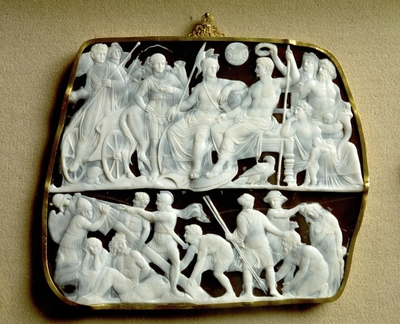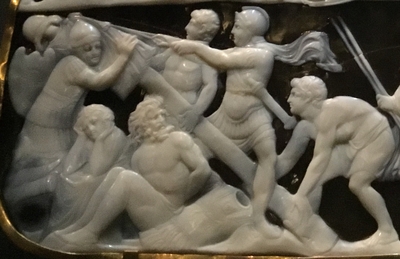Caesar Augustus (63 B.C.-A.D. 14), the founder and great expansionist of the Roman Empire, the architect of the Pax Romana, the creator of a golden economic age, the instigator of grand civic structures, was also an eminent patron of the arts. In the years leading up to his death, he—or a supporter, perhaps?—commissioned a magnificent cameo glorifying his deeds. It is surely the finest and almost the largest cameo that survives from antiquity.
 Known as the Gemma Augustea, it tells a story that unfolds in two frieze-like registers. In the upper level, Roma, the goddess of Rome, sits at the center on her throne in a relaxed pose, her eyes meeting those of Augustus, enthroned just to the right. Their knees almost touch. Augustus, his chiseled face in profile and his muscled body naked from the waist up, holds in his right hand a lituus, a crooked wand used by augurs for divination. Behind him is Oikoumene, a goddess who personified the civilized world, about to place a military wreath known as a corona civica on his head. Below his throne is an eagle, symbol of Jupiter, touched by the hem of Augustus' garment. Further to the right are Tellus Italiae, a goddess personifying Italy in all its fecundity, who holds a cornucopia, and Oceanus, god of the sea.
Known as the Gemma Augustea, it tells a story that unfolds in two frieze-like registers. In the upper level, Roma, the goddess of Rome, sits at the center on her throne in a relaxed pose, her eyes meeting those of Augustus, enthroned just to the right. Their knees almost touch. Augustus, his chiseled face in profile and his muscled body naked from the waist up, holds in his right hand a lituus, a crooked wand used by augurs for divination. Behind him is Oikoumene, a goddess who personified the civilized world, about to place a military wreath known as a corona civica on his head. Below his throne is an eagle, symbol of Jupiter, touched by the hem of Augustus' garment. Further to the right are Tellus Italiae, a goddess personifying Italy in all its fecundity, who holds a cornucopia, and Oceanus, god of the sea.
The intent is unmistakable: Augustus is exalted as nearly divine. (Soon after his death he was, in fact, deemed a god.)
The left half of the upper register carries a different but equally potent message. Near the edge is Tiberius, the stepson Augustus adopted as his heir. Holding a staff, he has arrived in a chariot with none other than winged Victory, but is now alighting, as if encouraged by her to move on to the next military challenge. To the right is Germanicus, the nephew Tiberius adopted as his heir at the behest of Augustus, in military dress. Here Augustus is setting forth his plans for a dynasty that will wage war to expand the Roman realm and extend the prosperity he engineered.
The lower register displays a moment of triumphalism whose meaning may be keyed to the date of the Gemma's making (A.D. 9-12): In the year 9, the Roman army conquered the Pannonians with Tiberius as general. The cameo, on the left, depicts Roman soldiers raising a victory monument over their enemies, one clearly stripped of his armor and with hands tied behind his back. On the right, it shows the enemy being yanked into captivity by a pair that may be Mercury and Diana, a sign that the gods sided with the Romans. And this is all happening—literally—at the feet of Augustus and Roma. (The Roman army also suffered a defeat at the hands of Germanic tribes in A.D. 9, and an alternative interpretation holds that the lower register presents a counter-narrative to that setback. Either way, it's propaganda.)
 Detail |
Testament to the Gemma's superiority is clearly on view at Vienna's Kunsthistorisches Museum, where it hangs in its own vitrine in a gallery filled with other ancient cameos. They do not compare in quality, nor can the one known larger ancient Roman cameo, the 12.2 inch by 10.5 inch Grand Camée de France, created at least a decade later in the first century.
 Detail |
And it did travel. For more than a millennium, the Gemma's whereabouts is unknown, though various theorists place it in Constantinople, then returned to the West by crusaders. In the mid-13th century, it resurfaces in an ecclesiastical inventory in Toulouse, France. In 1533, Francis I has it at Fontainebleau, but it disappears from written record again until around 1600, when it reappears in Venice. There it was purchased by the Habsburg Holy Roman Emperor Rudolph II for 12,000 golden ducats, becoming part of the Imperial collection. It came to the Kunsthistorisches Museum when it opened in 1891, and has been delighting visitors ever since.

